Grand Central Railroad Station, circa 1900-1915 [1] – 431 Franklin Street (near I-45 and Washington Avenue). Built in 1887, replaced in the 1934 by the Art Deco station that is now incorporated into Minute Maid Park, and demolished in 1960[3].
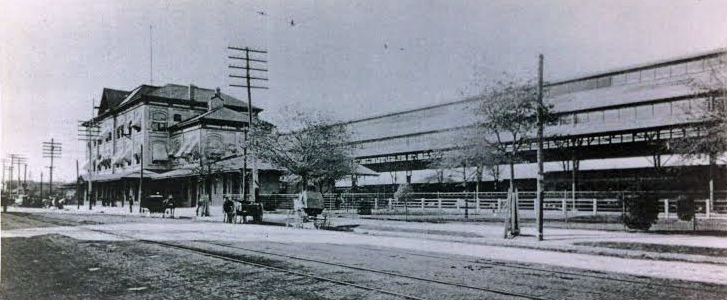 For many years, Houston advertised itself as “The City Where 17 Railroads Meet the Sea” to emphasize that it was a modern, technologically progressive city, capable of handling the bounty of crops the state produced. The locomotive was included on the city seal when it was adopted in February, 1840. The city fathers were optimistic: Houston wouldn’t have an operational rail line until 1853. The Buffalo Bayou, Brazos, and Colorado Railroad was the first railroad in the state and only the second west of the Mississippi. It was also the earliest branch of today’s Southern Pacific[4].
For many years, Houston advertised itself as “The City Where 17 Railroads Meet the Sea” to emphasize that it was a modern, technologically progressive city, capable of handling the bounty of crops the state produced. The locomotive was included on the city seal when it was adopted in February, 1840. The city fathers were optimistic: Houston wouldn’t have an operational rail line until 1853. The Buffalo Bayou, Brazos, and Colorado Railroad was the first railroad in the state and only the second west of the Mississippi. It was also the earliest branch of today’s Southern Pacific[4].
Baptist Sanitarium, circa 1917: Resurrecting another blog post (October 1, 2010) brings us back to Baptist Sanitarium, before it became Memorial Hospital and then half of Memorial Hermann. An anonymous nursing student[5] kept a photo album in the few years leading up to World War I. The hospital in those days was on an unpaved street, and on a streetcar line.
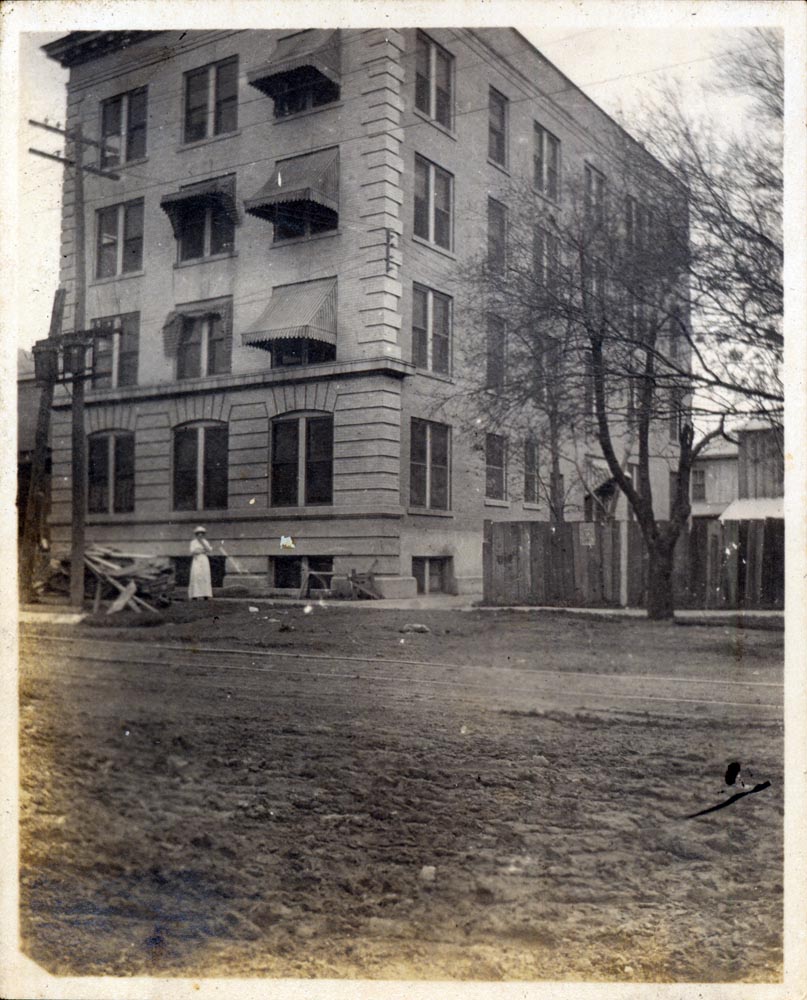 Young men and cars, circa 1917: The back of the album has pictures that seem to be of friends, family, and travel destinations, and finally of Fort Sam Houston during the War. One of the informal pictures is of two young men and their cars. The car on the left is an early 1910’s Ford[6]:
Young men and cars, circa 1917: The back of the album has pictures that seem to be of friends, family, and travel destinations, and finally of Fort Sam Houston during the War. One of the informal pictures is of two young men and their cars. The car on the left is an early 1910’s Ford[6]:
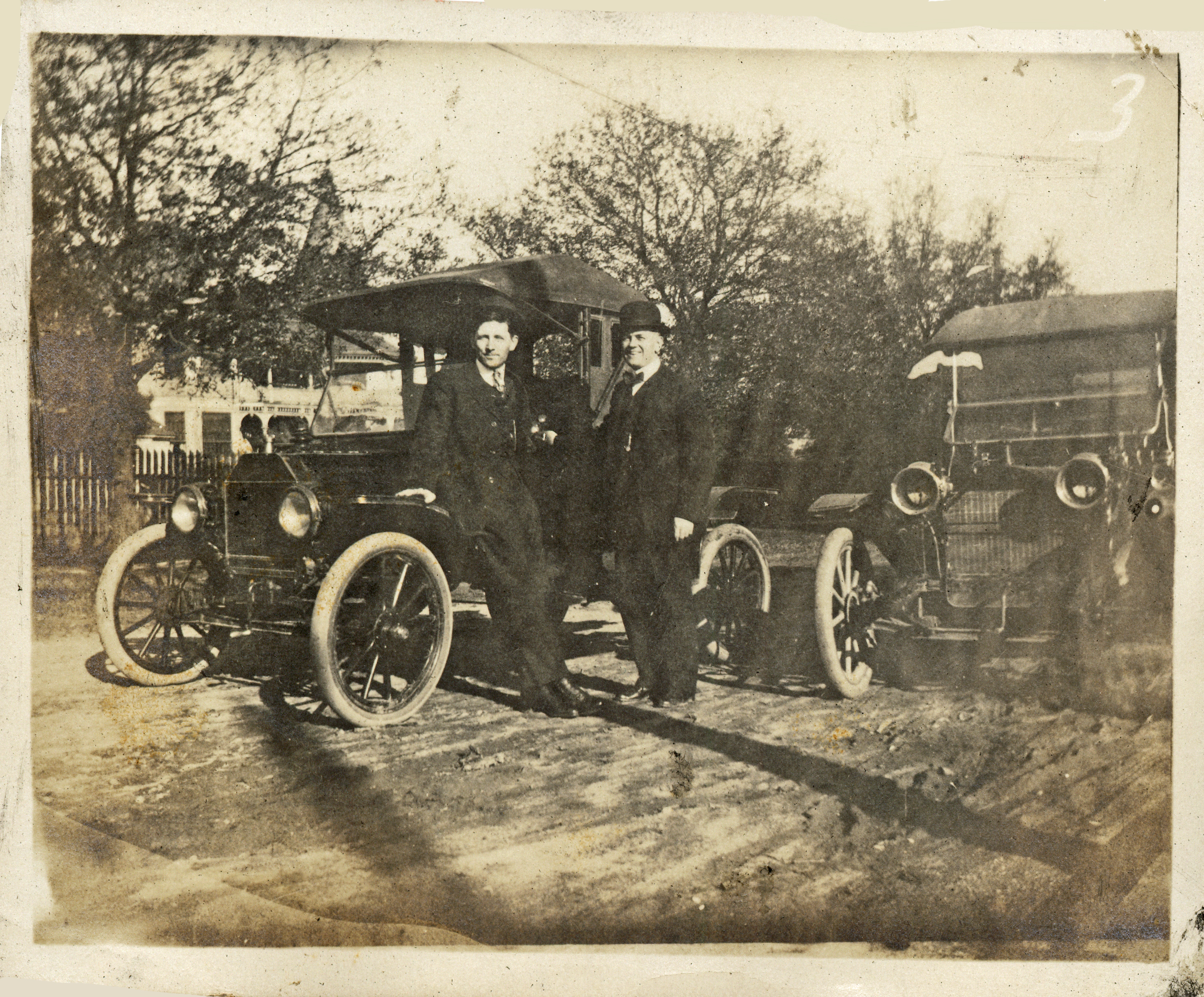 The second car presented something of a challenge. The quality of the original photo isn’t great and a lot of the detail was blotted out by intense lighting, awkward photo exposure, and age. The shape of the grille was extremely common in the early- to mid-1910’s and is of little help, but the high-set headlights, tall radiator cap ornament, and metal “apron” below the grille itself are unusual.
The second car presented something of a challenge. The quality of the original photo isn’t great and a lot of the detail was blotted out by intense lighting, awkward photo exposure, and age. The shape of the grille was extremely common in the early- to mid-1910’s and is of little help, but the high-set headlights, tall radiator cap ornament, and metal “apron” below the grille itself are unusual.
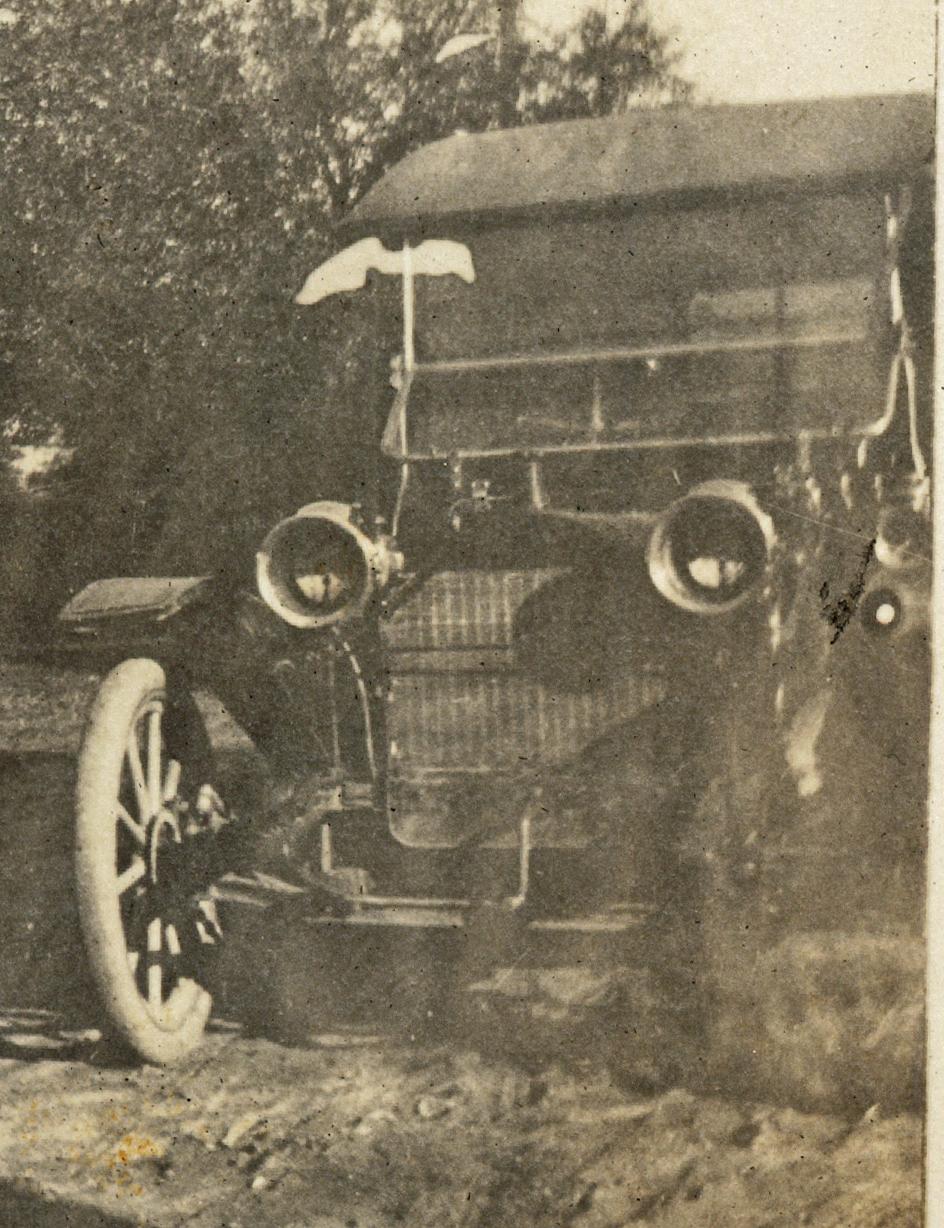 A lot of Googling and an email to a car club confirmed that it is a 1912 or 1913 Hupmobile[8] Both the Ford and the Hupmobile[9] would have been inexpensive cars.
A lot of Googling and an email to a car club confirmed that it is a 1912 or 1913 Hupmobile[8] Both the Ford and the Hupmobile[9] would have been inexpensive cars.
Houston Light Guards, circa 1900[10]: The Light Guards formed in 1873 as an early militia group. Their original Romanesque armory was built at Texas Avenue and Fannin Street in 1893. It was sold in 1925 and the Light Guard built a new Art Deco home on Caroline Street[11]. The second building[12] now houses the Buffalo Soldiers Museum[13].
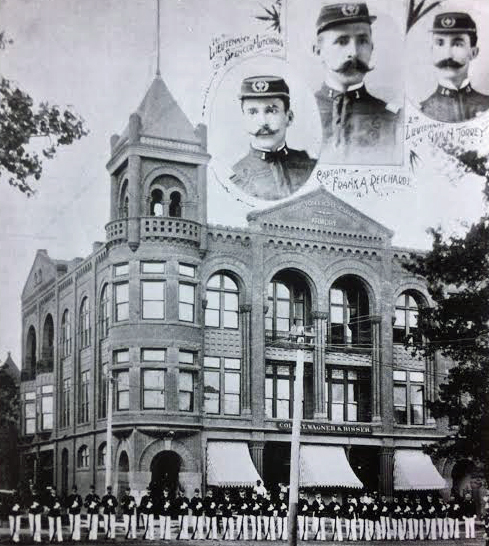 Hermann Estate office and staff, circa 1910-1920[14]: We think this was at the Stewart Building office (1906-1973) at Fannin and Preston. According to the Bayou City History blog (2012 June 5), it was the first reinforced concrete building in the city[15].
Hermann Estate office and staff, circa 1910-1920[14]: We think this was at the Stewart Building office (1906-1973) at Fannin and Preston. According to the Bayou City History blog (2012 June 5), it was the first reinforced concrete building in the city[15].
The clock above the rolltop desk advertises “G.A. Pfeiffle[?] Watch Inspector, S.S.&S. Ry, Greenville,Tex.” This would have been the Sherman, Shreveport, and Southern Railway, which had its offices in Greenville and was sold to the MKT in 1901[16]. Apparently the Estate staff frugally bought secondhand clocks.
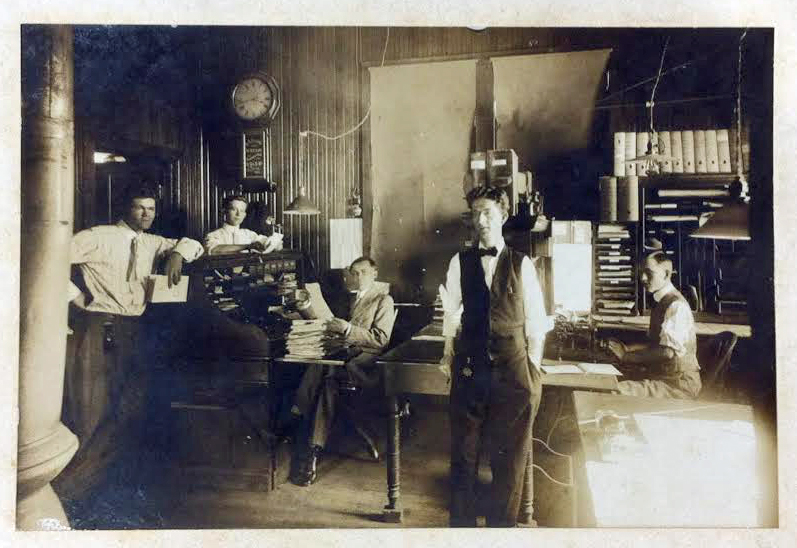 McKinney between Main and Travis, circa 1920[17]: The church at left is the 1896 Romanesque home of the First Presbyterian Church. This building burned in 1932[18]. It was near the old Carnegie library at Main and Fannin[19].
McKinney between Main and Travis, circa 1920[17]: The church at left is the 1896 Romanesque home of the First Presbyterian Church. This building burned in 1932[18]. It was near the old Carnegie library at Main and Fannin[19].
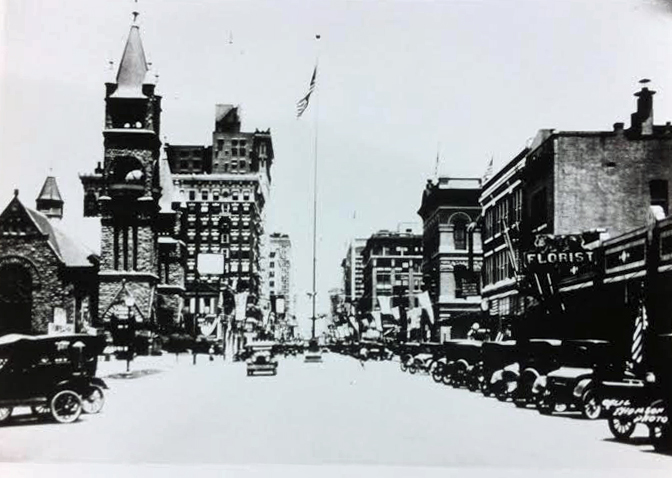 Main at Commerce, circa 1900[20]: The Chimene Furniture Company, visible in the distance, was located at 210 Main Street. The building that housed it was demolished and replaced in 1904 by a new office building[21]. Other businesses include a dry good shop advertising books, stationary, and clothing; a book exchange, and something called the Racket Store, which seems to have been a type of dry goods or general store.
Main at Commerce, circa 1900[20]: The Chimene Furniture Company, visible in the distance, was located at 210 Main Street. The building that housed it was demolished and replaced in 1904 by a new office building[21]. Other businesses include a dry good shop advertising books, stationary, and clothing; a book exchange, and something called the Racket Store, which seems to have been a type of dry goods or general store.
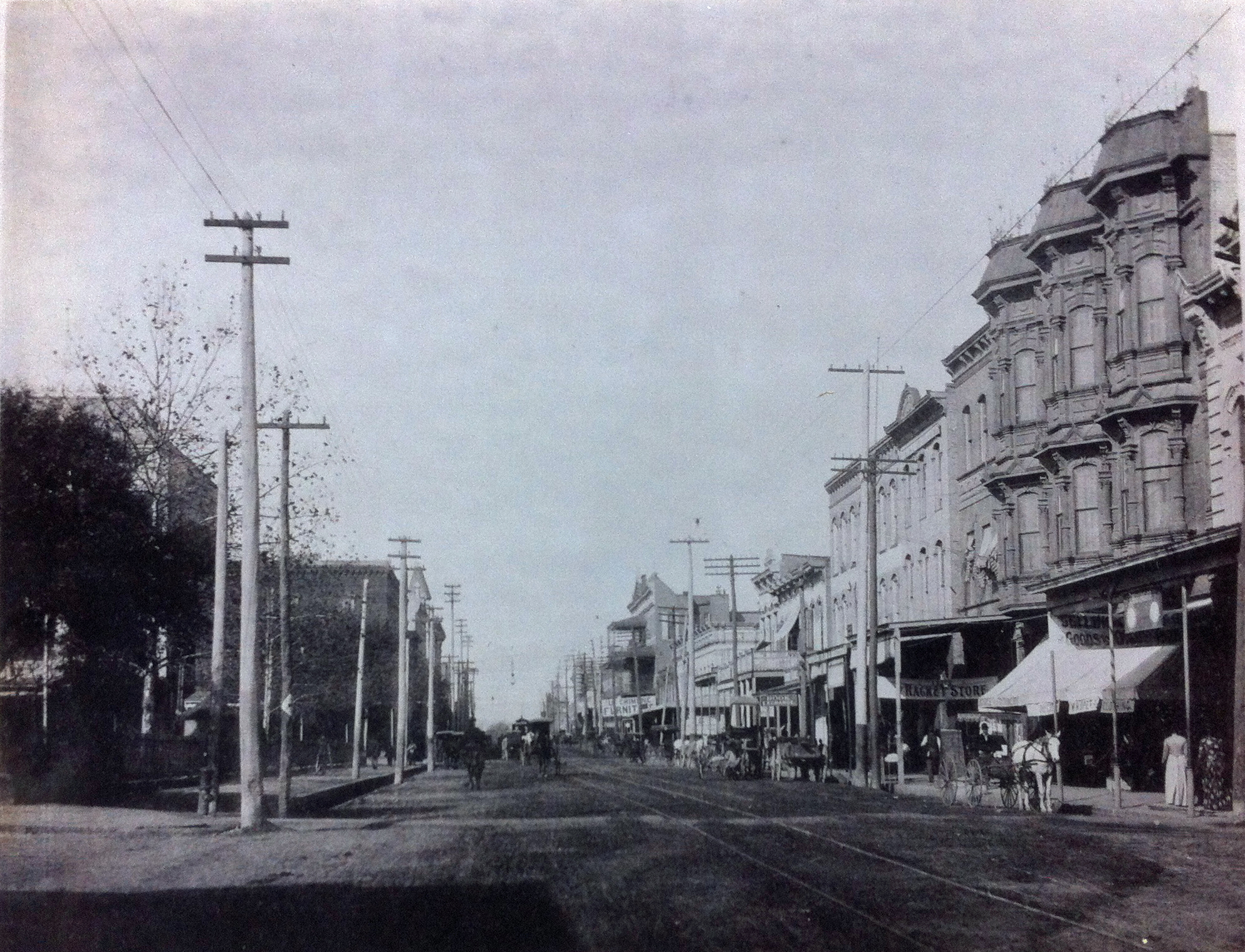 There is very little left now[22]:
There is very little left now[22]:
 210 Main may be the building that replaced Chimene’s[23].
210 Main may be the building that replaced Chimene’s[23].
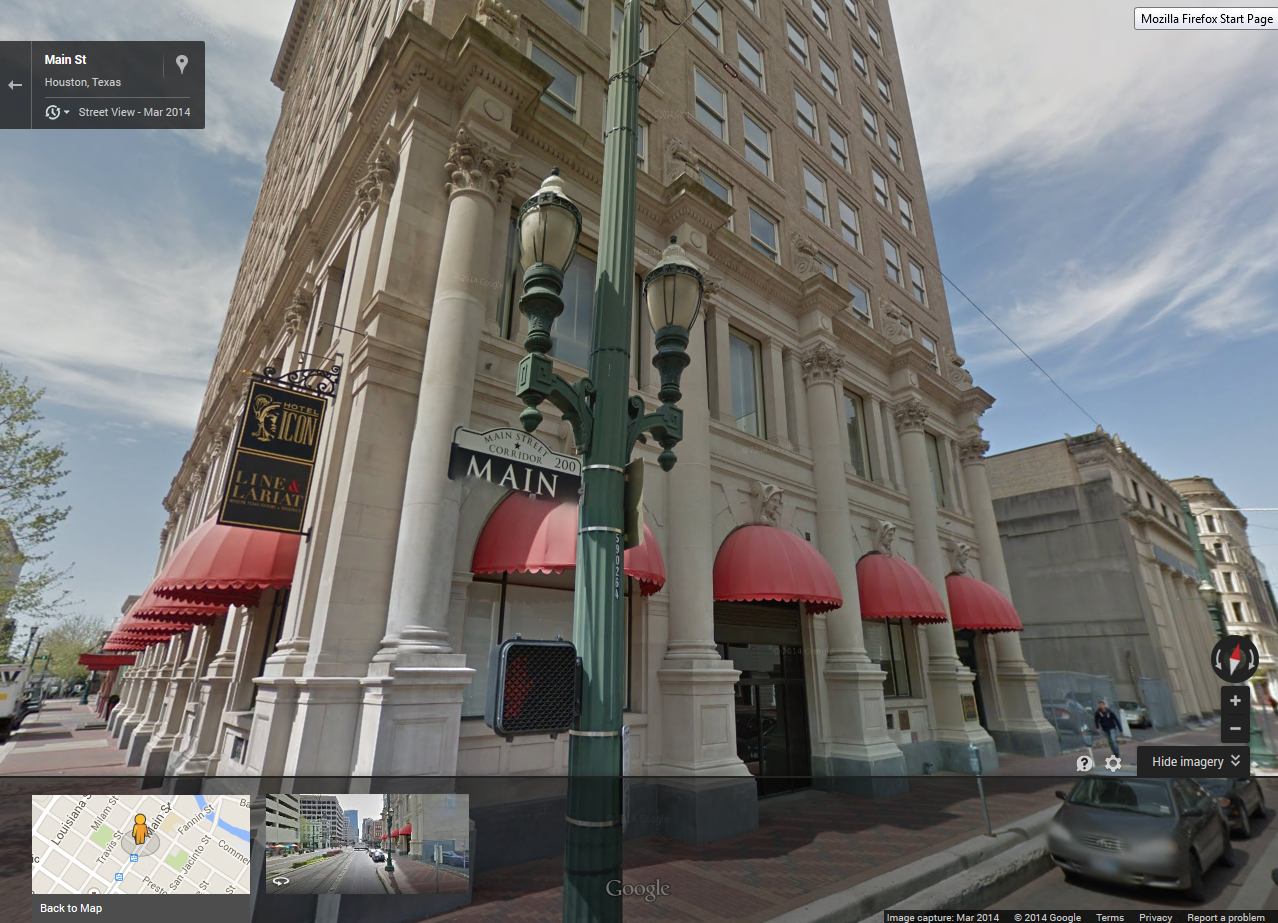 The building across the street with the conical tower, though, is still there[24]:
The building across the street with the conical tower, though, is still there[24]:
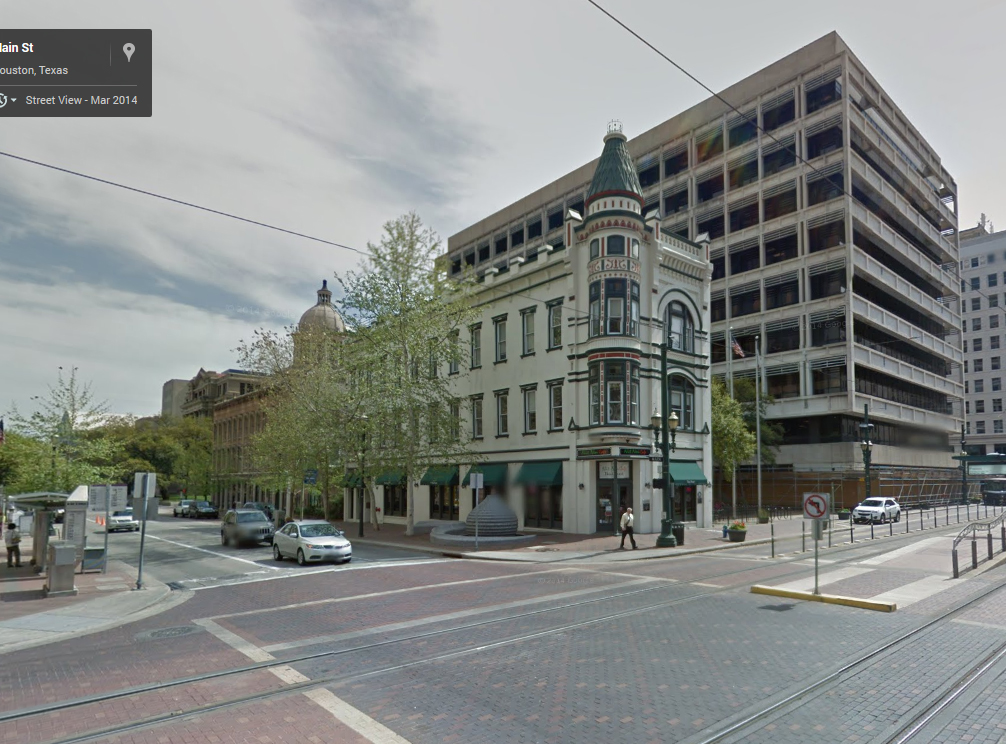 Sources consulted:
Sources consulted:
[1] McGovern Research Center Hermann History photo collection, folder 24.
[2] University of Houston Library digital image collection, Historic Houston Photographs.
[3] Chicago rail fan.com, Houston.
[4] Houston Business Journal, Betty T. Chapman, January 14, 2011, “Grand Central Station: The place where ’17 railroads meet the sea'”.
[5] McGovern Research Center, Institutional Collection 022, Baptist/Memorial, World War I nursing scrapbook.
[6] Hubcap Cafe.com, Ford.
[7] LaFierre Classic Cars, 1911 Hupmobile 20.
[8] Hupmobile Club.
[9] Wikipedia: Hupmobile.
[10] McGovern Research Center Hermann History photo collection, folder 24.
[11] Handbook of Texas Online: Houston Light Guards.
[12] OffCite.org, Jesse Hager, March 26, 2009, “A Building Worth Saving“.
[13] Buffalo Soldiers National Museum.
[14] McGovern Research Center Hermann History photo collection, folder 18.
[15] Bayou City History Blog, June 5, 2012, “Photos show the heyday and end of the Stewart Building“.
[16] Handbook of Texas Online: Sherman, Shreveport, and Southern Railway.
[17] McGovern Research Center Hermann History photo collection, folder 25.
[18] First Presbyterian Church, Houston, Our Story.
[19] Wikipedia: Houston Public Library.
[20] McGovern Research Center Hermann History photo collection, folder 24.
[21] Galveston Daily News, October 12, 1904, “Houston News” section. Found on MyHeritage.com.
[22], [23], [24] Google Maps.